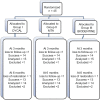In vivo Outcomes of Indirect Pulp Treatment in Primary Posterior Teeth: 6 Months' Follow-up
- PMID: 29962767
- PMCID: PMC6006903
- DOI: 10.4103/ccd.ccd_48_18
In vivo Outcomes of Indirect Pulp Treatment in Primary Posterior Teeth: 6 Months' Follow-up
Abstract
Background: Indirect pulp treatment (IPT) is a minimally invasive procedure based on the application of a protective liner on the affected dentin, thereby preserving the pulp vitality.
Aim: This study aims to evaluate and compare the clinical and radiographic outcomes of IPT when a layer of calcium hydroxide (Dycal), mineral trioxide aggregate (MTA), or Biodentine was placed over the affected dentin in primary molars.
Materials and methods: A clinical trial with sample size of 45 primary molars between the age group of 4-9 years, of which 15 teeth were considered, each for Group I (Dycal), Group II (MTA), and Group III (Biodentine). Measurements on digitized radiographs were made at baseline, 3, and 6 months using Corel Draw software.
Results: One-way ANOVA and post hoc tests indicated a statistically significant difference in dentin thickness (P < 0.05) in all the groups. Within Group I, the thickness of dentin was 0.066 ± 0.009 mm at 3 months and 0.099 ± 0.011 mm at 6 months. In Group II, 0.081 ± 0.010 mm at 3 months and 0.123 ± 0.016 mm at 6 months. In Group III, 0.102 ± 0.021 mm at 3 months and 0.154 ± 0.022 mm at 6 months.
Conclusions: Clinically, 100% success rate was observed in all the groups whereas radiographically, Biodentine was superior to both the groups.
Keywords: Biodentine; Dycal; indirect pulp treatment; mineral trioxide aggregate; remaining dentine thickness.
Conflict of interest statement
There are no conflicts of interest.
Figures



References
-
- Ribeiro CC, de Oliveira Lula EC, da Costa RC, Nunes AM. Rationale for the partial removal of carious tissue in primary teeth. Pediatr Dent. 2012;34:39–41. - PubMed
-
- Fuks AB. Current concepts in vital primary pulp therapy. Eur J Paediatr Dent. 2002;3:115–20. - PubMed
-
- Camilleri J, Montesin FE, Brady K, Sweeney R, Curtis RV, Ford TR, et al. The constitution of mineral trioxide aggregate. Dent Mater. 2005;21:297–303. - PubMed
-
- Zanini M, Sautier JM, Berdal A, Simon S. Biodentine induces immortalized murine pulp cell differentiation into odontoblast-like cells and stimulates biomineralization. J Endod. 2012;38:1220–6. - PubMed
LinkOut - more resources
Full Text Sources
Other Literature Sources

